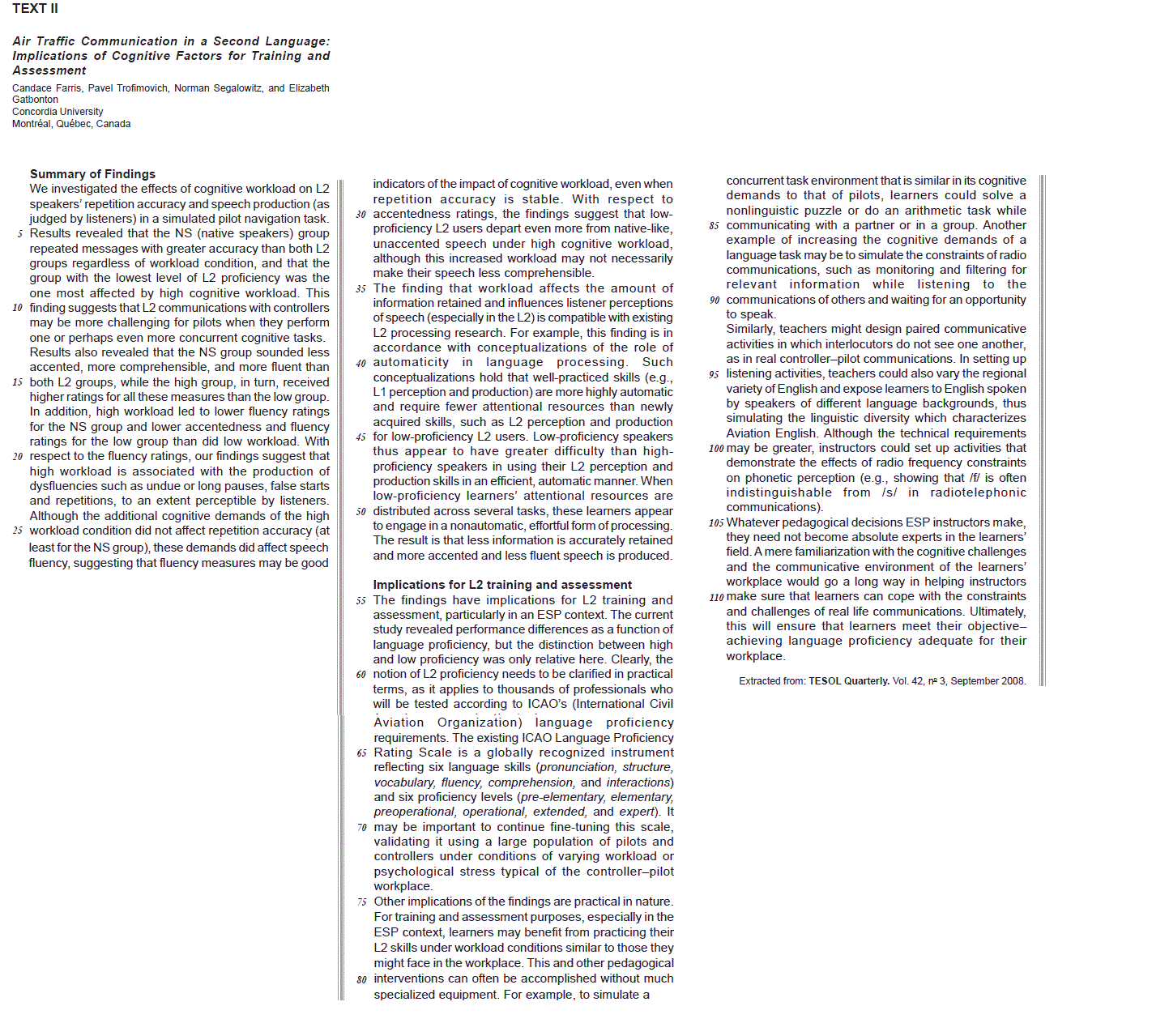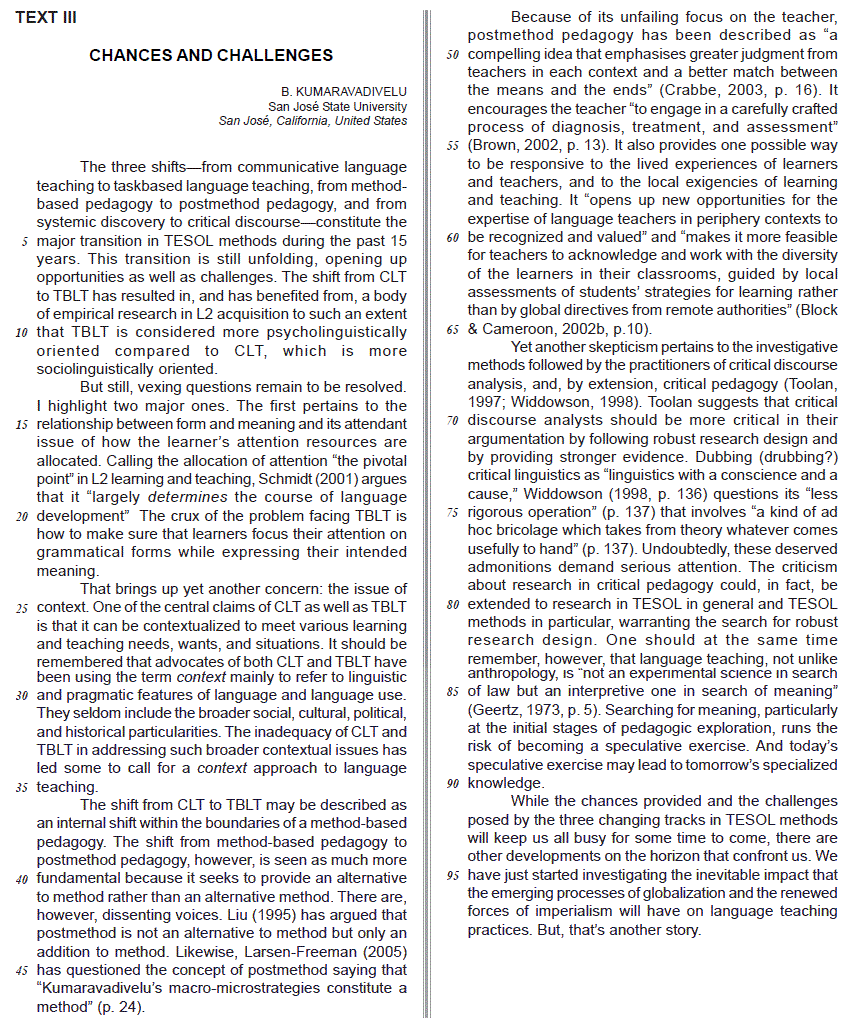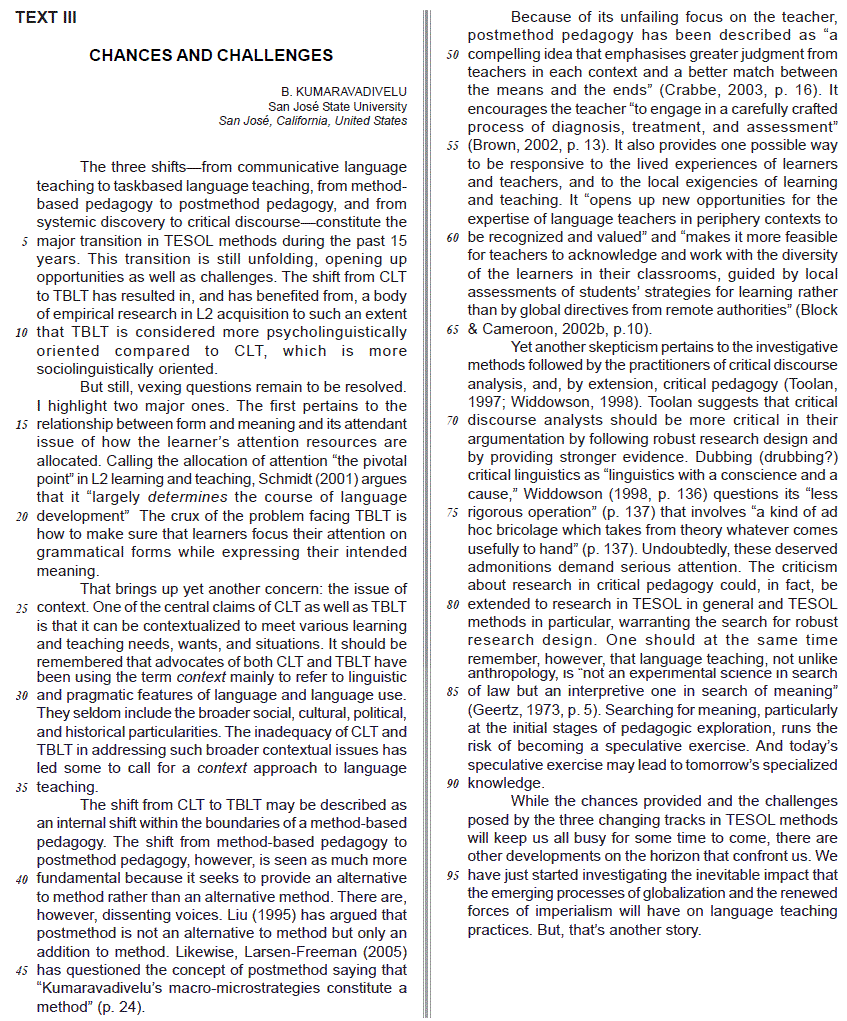Questões de Língua Inglesa do ano 2009
Lista completa de Questões de Língua Inglesa do ano 2009 para resolução totalmente grátis. Selecione os assuntos no filtro de questões e comece a resolver exercícios.

In paragraph 4 (lines 55-74), the authors mention that it may be important to continue fine-tuning the ICAO Language Proficiency Rating Scale because
- A.
it should take into account the different amounts of work or the psychological stress undergone by L2 pilots and controllers in their real life environment.
- B.
it does not cover as many language skills and proficiency levels as necessary to validate pilots and controllers performance in the L2.
- C.
it does not consider the ICAOs language proficiency requirements for aviation professionals.
- D.
the number of air traffic controllers and pilots who need to be tested is very large.
- E. the proficiency levels of the high L2 and low L2 groups are very different.
In the excerpt Other implications of the findings are practical in nature. For training and assessment purposes, especially in the ESP context, learners may benefit from practicing their L2 skills under workload conditions similar to those they might face in the workplace. (lines 75-79), the concept embedded in the use of the acronym ESP is appropriately described by:
- A.
English for Specific Purposes, comprehending the practicing of the language skills needed to behave adequately in the profession.
- B.
English for Scientific Professions, involving the learning of the language structures and lexicon used in science and technology.
- C.
English for Special Professions, teaching the aural-oral skills necessary to communicate in special professional fields.
- D.
English for Special Purposes, including teaching all 4 skills for students of different age and national backgrounds.
- E.
English for Specific Purposes, encompassing strategies to teach academic reading proficiency, exclusively.
In line 78, those refers to
- A.
Other implications of the findings... (line 75)
- B.
...training and assessment purposes, (line 76)
- C.
learners... (line 77)
- D.
...L2 skills... (line 78)
- E. ...workload conditions... (line 78)
In A mere familiarization with the cognitive challenges and the communicative environment of the learners workplace would go a long way in helping instructors make sure that learners can (lines 107-110), the expression in bold could be replaced by
- A.
suffice to help
- B.
not be able to help
- C.
be very successful in helping
- D.
require lengthy efforts to help
- E.
make long-lasting contributions to help
In the last paragraph (lines 105-114), the author suggests that
- A.
the communicative environment in the learners workplace does not reflect the challenges of real life communication.
- B.
learners will only meet their objective provided they are offered intensive language training and rehearsal in their workplace.
- C.
ESP instructors need to be fully knowledgeable in the technical skills required in the learners workplace.
- D.
ESP instructors are expected to have a general idea of the professional tasks and interactional needs of the learners without a thorough background in technical issues.
- E.
ESP instructors must develop an extensive knowledge of aviation as well as of Aviation English in order to help learners cope with the everyday challenges of their workplace.
Check the option that introduces an implication of the research study reported in Text 2.
- A.
It is not necessary to refine the scale of language proficiency within realistic scenarios.
- B.
It is pointless to monitor and extract relevant data from the communications of pilots and air traffic controllers.
- C.
There is an urgent need of highly-specialized equipment to simulate the workplace context for pedagogical purposes.
- D.
There must be lifelike L2 training and assessment in air traffic controllerpilot communication under workload conditions.
- E.
There is no link between performance dissimilarities and language proficiency in the communication between pilots and air traffic controllers.
There is no link between performance dissimilarities and language proficiency in the communication between pilots and air traffic controllers.
- A.
While the high L2 group sounded less accented, more comprehensible and more fluent than the low L2 group, the NS group performed better than both L2 groups in these measures.
- B.
Undue or long pauses, repetitions and false starts are dysfluencies imperceptible by listeners.
- C.
Since the NS group members had their fluency affected by additional cognitive demands of high workload conditions, fluency measures may be a good indicator of cognitive overload.
- D.
Both the amount of retained information and the listeners perception of speech are affected by the workload.
- E. High cognitive workload worsens the speech production of low-proficiency L2 speakers.

The communicative intention of Text 3 is to
- A.
describe the past challenges in TESOL Methods from a historical perspective.
- B.
criticize the interpretation of the three major shifts in TESOL Methods as challenging trends.
- C.
comment on the three major shifts in TESOL Methods and their influences on current challenging trends.
- D.
blame the three major shifts in TESOL Methods for all the current problems in language teaching.
- E.
endorse the inappropriateness of the three major shifts in TESOL Methods as guidelines for current challenging trends.

This passage is most likely part of
- A.
a historical survey of trends in the EFL scenario.
- B.
a journal entry of an in-service teacher diary in her first teaching experience.
- C.
a state-of-the-art essay taking stock on recent developments in TEFL.
- D.
a textbook on language teaching methodologies for pre-service teachers.
- E.
an essay on how to overcome the fear of teaching.

Schmidt (2001) argues that it largely determines the course of language development (lines 18-20) It should be remembered that advocates of both CLT and TBLT have been using the term context mainly to refer to linguistic and pragmatic features of language and language use. (lines 27-30)
Which of the alternatives below correctly explains the use of italics in the two fragments above?
- A.
The author intended to emphasize the words determines and context as they had been mentioned previously.
- B.
The author italicized the word determines to stress the idea of causation; the italics in context substitutes for quotation marks.
- C.
The words determines and context were italicized for emphasis since they represent ideas exposed by others, not the author himself.
- D.
The italics in the term context refers to a newly-coined term in LT methodology; the word determines in italics reveals that Schmidt was too authoritative in choosing this term.
- E.
Both words (determines and context) are terms employed by others and explained by the author of this text.


